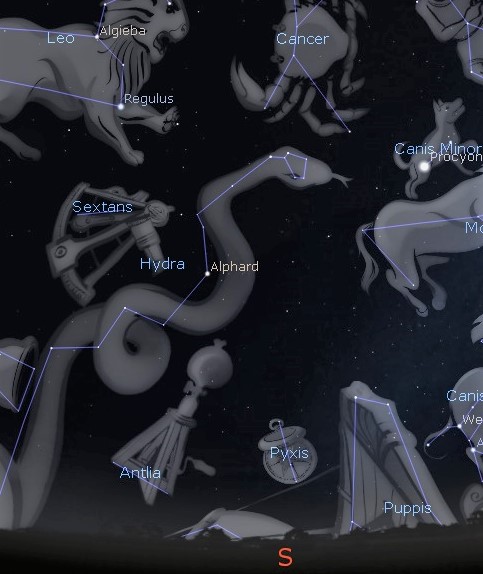This Week’s Sky at a Glance, 2022 March 5 – 12 ~by Curt Nason
This is a good time to search for a few obscure constellations, if you are up for the challenge. The trio will be at their best, as it were, an hour or two before midnight. You will need dark, clear skies and a good view to the south.
Below Regulus, at the heart of Leo, and to the left of Alphard in serpentine Hydra, is a collection of faint stars that forms Sextans the Sextant. Johannes Hevelius, the creator of Leo Minor, came up with this constellation to commemorate the sextant that he used for measuring star positions, and which he lost when his observatory burned in 1679. Good luck with seeing a sextant here; perhaps it represents what was left after the fire.
Below Sextans and Hydra, very near the horizon, is Antlia the Air Pump. Nicholas Louis de La Caille was an 18th century astronomer who also created obscure constellations to fill in gaps in the sky. The laboratory air pump is one of several scientific instruments honoured with a position in the stars during that era, but in our sky it seems to be past its prime. If you think of a compass as a needle then Pyxis the Compass does look like what it represents. It is between Antlia and Puppis to its right, again low in our sky even at its best. Originally part of the mast of Argo Navis in Ptolemy’s star chart, La Caille re-imagined it as a mariner’s compass, although it is pretty much lost in our sky.
This Week in the Solar System
Saturday’s sunrise in Moncton is at 6:50 am and sunset will occur at 6:11 pm, giving 11 hours, 21 minutes of daylight (6:55 am and 6:16 pm in Saint John). Next Saturday the Sun will rise at 6:37 am and set at 6:20 pm, giving 11 hours, 43 minutes of daylight (6:42 am and 6:26 pm in Saint John).
The Moon will be within a binocular view below Uranus on Sunday evening around 8:30, and it is at first quarter on Wednesday. Venus and Mars slide in tandem along the ecliptic this week, with Mars being within a binocular view to the lower right of Venus. Saturn trails them by an hour this weekend, while Mercury is within a binocular view to the lower left of the ringed planet but heading sunward. Jupiter is in solar conjunction this Saturday.
On Sunday evening at 8 pm, tune in to the Sunday Night Astronomy Show via the Facebook page or YouTube channel of Astronomy by the Bay.
Questions? Contact Curt Nason.

